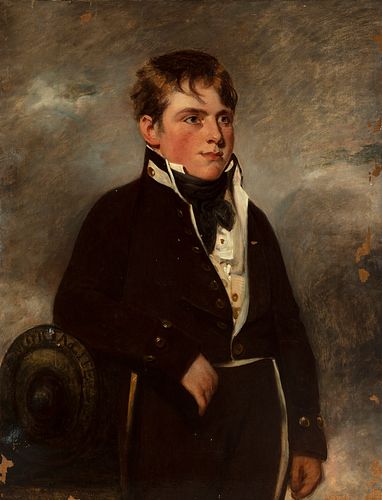English school, ca. 1820. Circle of SIR THOMAS LAWRENCE (Bristol, 1769 - London, 1830). "Portrait of a Child. Oil on canvas. Relined Missing paint. Si
Lot 123
About Seller
Setdart Auction House
Carrer Aragó 346
Barcelona
Spain
Setdart Subastas was born in 2004 and is currently the first online art auction in Spain with solidity, prestige and reliability guaranteed by our more than 60,000 users. Setdart has a young, dynamic and enterprising team ready to successfully manage the purchase and sale of art works through custom...Read more
Estimate:
EUR€3,500 - EUR€4,000
$3,763.44 - $4,301.08
Absentee vs Live bid
Two ways to bid:
- Leave a max absentee bid and the platform will bid on your behalf up to your maximum bid during the live auction.
- Bid live during the auction and your bids will be submitted real-time to the auctioneer.
Bid Increments
| Price | Bid Increment |
|---|---|
| EUR€0 | EUR€10 |
| EUR€200 | EUR€25 |
| EUR€500 | EUR€50 |
| EUR€1,000 | EUR€100 |
| EUR€3,000 | EUR€200 |
| EUR€5,000 | EUR€500 |
| EUR€10,000 | EUR€1,000 |
| EUR€20,000 | EUR€2,000 |
| EUR€50,000 | EUR€5,000 |
About Auction
By Setdart Auction House
Oct 20, 2021
Set Reminder
2021-10-20 07:30:00
2021-10-20 07:30:00
America/New_York
Bidsquare
Bidsquare : OLD MASTERS
https://www.bidsquare.com/auctions/setdart-auction-house/old-masters-7700
Setdart Auction House sofia@setdart.com
Setdart Auction House sofia@setdart.com
- Lot Description
English school, ca. 1820. Circle of SIR THOMAS LAWRENCE (Bristol, 1769 - London, 1830). "Portrait of a Child. Oil on canvas. Relined Missing paint. Size: 90 x 70 cm; 106 x 85 cm (frame). This portrait, close to Sir Thomas Lawrence's circle, represents a young Englishman dressed in a black coat with high collars. The natural, youthful face is enlivened by a gentle smile and has been treated with great delicacy, with a brushstroke that blends in without leaving obvious traces. The figure is set against a neutral background, but on the left is a legend inscribed on a circular shield. Both the composition and the workmanship of this excellent portrait fit in with the characteristics of the best English portrait painting of the first quarter of the 19th century, and especially with the work of Sir Thomas Lawrence and his closest circle. Sir Thomas Lawrence was, after the death of Joshua Reynolds in 1792, Britain's foremost portraitist. His early training was in Bath, where he learned the technique of pastel from William Hoare and the correct handling of oils from Thomas Barker. In 1787 he moved to London, where he exhibited his first works at the Royal Academy. He began to triumph thanks to his female portraits, such as that of Elizabeth Farren, in which we can already discern certain traits of sensitivity that he would develop in his more mature production. In 1791 he was admitted to the Royal Academy and the following year, following the death of Joshua Reynolds, he became the king's painter. In 1815 he was knighted and that same year the royal family commissioned a series of portraits for the Waterloo Chamber at Windsor Castle. In 1820 he succeeded Benjamin West as president of the Royal Academy. Lawrence's portraits were based on Reynolds's "grand style", but the Bristol painter opened the way for a new concept of portraiture with regard to the model, his personal bearing and his emotional portrayal. He succeeded in recovering a highly personal vision of his sitters, which was already typical of Romantic and Victorian portraiture. His models are presented in relaxed, natural poses, the brushstrokes are delicate, imperceptible in the faces and lighter and more sketchy in the clothes and the landscape, which almost always plays an important role.
- Shipping Info
-
In-house shipping available. Please inquire at admin@setdart.com.
-
- Buyer's Premium



 EUR
EUR CAD
CAD AUD
AUD GBP
GBP MXN
MXN HKD
HKD CNY
CNY MYR
MYR SEK
SEK SGD
SGD CHF
CHF THB
THB






